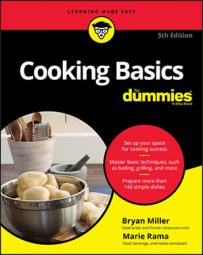Refrigeration extends the life of most fresh foods. Items that you want to keep very cold — milk, juice, stocks, beer, leftovers, and seafood, for example — should be placed in the back. And what about those crisper drawers? When closed, they create higher humidity, which is good for vegetables, especially lettuce and fresh herbs. And those little butter compartments prevent butter from drying out.
Don’t keep dairy and other highly perishables on the fridge door. Every time you open it — this can be 250 times or more a day if you have teenage boys — food warms up a bit. And, of course, don’t leave the door open for longer than is absolutely necessary.
Following are a few essential items to stock in the refrigerator or freezer:
Eggs: Never be without them, for omelets, breakfast foods, and quick dinners. Refrigerate eggs in the shipping carton to keep them from picking up odors and flavors from other refrigerated foods, and use them before the expiration or “use by” date stamped on the carton.
Fresh pasta: Stock various stuffed pastas, such as ravioli, in the freezer for quick dinners. You can wrap fresh pasta in freezer bags and store it for six to eight months. Don’t defrost before cooking; simply drop frozen pasta into boiling water and cook until al dente (tender but still pleasingly firm to the bite).
Milk: Whole milk has about 3.5 percent butterfat. If you prefer, use 1 percent (low-fat), 2 percent (reduced fat), or skim (nonfat) milk, with the understanding that the recipe may not have as creamy a consistency. If you don’t like milk or avoid dairy products, you can substitute soy, rice, coconut, or almond milk for regular milk in most recipes.
Sweet (unsalted) butter: Use unsalted sweet butter in all recipes so you can control the amount of salt. Butter has a refrigerator shelf life of about 2 to 3 weeks and can be frozen for 8 to 12 months in the original unopened carton or, if opened, in plastic freezer bags.
These items are nice to have, too:
Cottage cheese, ricotta, and cream cheese: Keep them on hand for adding to dressings and dips, snacking, spreading on bagels or toast, and for cheesecakes. Store in the original, covered container or foil wrapping and consume within 1 to 2 weeks.
Hard and semihard cheeses: Cheese has enjoyed somewhat of a renaissance in the United States, with a proliferation of artisanal cheese producers and cheese shops offering hundreds of types, so it’s easy to become a connoisseur if you so desire (and don’t mind asking questions at your local cheese counter).
For starters, stock mozzarella, Parmesan, cheddar, and blue cheeses for salads, casseroles, omelets, white sauces, and sandwiches; to grate into pasta; and just to snack on! Then expand your cheese horizons by tasting different cheeses whenever you can to determine what you like.
Wrap all cheese in foil, a resealable plastic bag, or plastic wrap after opening. Trim off any mold that grows on the outside edges of hard cheeses. Depending on its variety, cheese keeps in the refrigerator for several weeks to months.
Pre-grated Parmesan or Romano cheese quickly loses its potency and absorbs the odors of other refrigerated foods. Instead of buying pre-grated, keep a tightly wrapped wedge in the fridge and grate as needed. Or, if you’ll use it all right away, save time with a high-quality Parmesan or Romano that has been freshly grated at the deli.
Heavy cream, light cream, or half-and-half: They’re great for making quick pan sauces for fish, poultry, and pasta. Use within a week of purchase or freeze for longer storage. Heavy cream (not half-and-half or light cream) is used for making whipped cream.
Ice cream or frozen yogurt: Instant dessert (and great for eating guiltily in bed at midnight)! After you open it, you should eat ice cream and frozen yogurt within 2 weeks. You can freeze unopened containers for up to 2 months.
Plain yogurt: This is a good ingredient for quick dips and low-fat sauces. It also makes pancake batters lighter. Follow the expiration date on the package.
Sour cream: You can use standard (18 percent fat), low-fat, and nonfat sour cream interchangeably in recipes. As with all dairy products, heed the expiration date.

